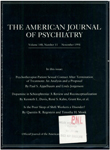Infrequent occurrence of EEG abnormalities in panic disorder
Abstract
EEG abnormalities have been frequently reported in patients with panic disorder, although controlled studies are lacking. The authors examined the EEGs of 35 consecutively evaluated, medication-free patients with panic disorder and found that only five (14%) had nonspecific abnormal EEGs and none displayed EEG evidence supportive of an ictal process. The presence or absence of EEG abnormalities was not significantly associated with the presence or absence of psychosensory symptoms. Although it is not likely that panic disorder is an epileptiform disorder, temporal lobe and limbic structures probably play a major role in the pathophysiology of panic.
Access content
To read the fulltext, please use one of the options below to sign in or purchase access.- Personal login
- Institutional Login
- Sign in via OpenAthens
- Register for access
-
Please login/register if you wish to pair your device and check access availability.
Not a subscriber?
PsychiatryOnline subscription options offer access to the DSM-5 library, books, journals, CME, and patient resources. This all-in-one virtual library provides psychiatrists and mental health professionals with key resources for diagnosis, treatment, research, and professional development.
Need more help? PsychiatryOnline Customer Service may be reached by emailing [email protected] or by calling 800-368-5777 (in the U.S.) or 703-907-7322 (outside the U.S.).



